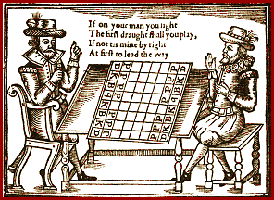|
The 1902 International Chess Tournament of Monte Carlo
Monte Carlo
February 1, 1902 -
It's 9:00 PM on Saturday night and the great hall where the some of the
most noted chess players of the time will assemble for the next five weeks
is buzzing with activity. Even though the drawing of names would begin on
Sunday, the most distinctive sound that permeates the hall this evening,
and every evening thereafter, is that unique musical hum of the
roulette wheels coupled with the pings of the ivory balls. The chess tournament will command the attention of the press and
publicize the name of Monte Carlo throughout the world, but gambling pays
the bills.
The sound of the roulette wheel is only a symbol of the uniqueness of
Monte Carlo. And understanding its singularity adds a dimension of
richness to the
overview of any or all of the four tournaments held there from 1901-1904.
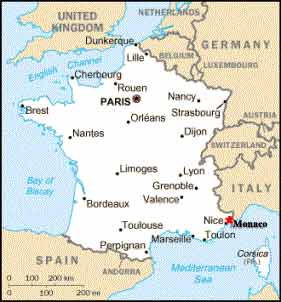
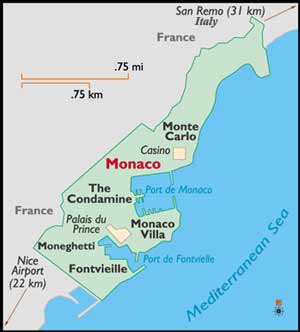
Cradled between the southern tip of the French Alps and the Mediterranean
Sea, Monaco has one of the most temperate climates on Earth. In
February, the dead of winter, when most places are feeling the effects of
the season, Monaco maintains a mean temperature of 8° C (47° F) while in
summer the mean is just 26°C (78°F). With little manufacturing, agriculture or
industry, Monaco depends upon its natural blessings to sustain itself. As
the smallest principality in the world, next to the Vatican, Monaco
makes the most of its mere .75 sq. mile and beautiful French
Riviera location by promoting and catering to tourism.
Monaco had a stormy past, but for our purposes, it begins in 1860 when
Prince
Charles III of Monaco signed the Franco-Monegasque Treaty which ceded to
France 80% of what comprised Monaco in exchange for 4 million francs and
complete autonomy as a protectorate of France. It also left Monaco, the poorest nation in Europe, with no source of revenue
other than what it earned from the sale of salt and custom rights to
France. The land, what little there was, proved unsuitable for agriculture and the location
itself was very inaccessible
Charles and his mother Princess Caroline had little choice but to
develop a strategy to bring money into Monaco. Even before the treaty,
Princess Caroline, aware that gambling casinos had been outlawed first in
France and more recently in Germany, had pushed for creating a gaming establishment
to fill that profitable void.
In 1857 they formed companies called the "Sea-Bath Society" or the "Société des Bains de Mer" and the
"Foreigner's Club of Monaco" or the "Cercle des Etrangers
de Monaco" [1] to operate the first casino, the Villa Bellevue.
But this venture met with
little success. After the treaty, now with some seed money, they brought
in
experienced outside help. This help came in 1863 with the arrival of François Blanc
and his wife Marie, lately of Homburg, Germany, where he had
successfully operated a casino/spa. Blanc paid 2 million francs for the
franchise to operate the casino
that was newly constructed on the rocky Plateau des Spélugues (the Plain
of Caverns). Blanc took over the Société des Bains de Mer et Cercle des Etrangers
de Monaco and bought out the Villa Bellevue. He negotiated to
receive a 50 year commission to operate a casino from which the Prince
would receive 400 shares in the Sea-Bath Company, 10% of the profits and a
stipend of 154,000 francs/year.
The game of roulette had been around for a while,
mostly in the form introduced by Gabriel de Sartine in Paris. Roulette was
popular with casinos since it was difficult to cheat against.
François Blanc, along with his twin brother, Louis, redesigned the French
roulette wheel which had 38 slots - 36 slots numbered 1-36, plus a 0 slot
and a 00 slot. The Blanc's version had only 37 slots since they eliminated
the 00 slot. This design gave the house slightly less favorable odds (from
a 5.26% edge to a 2.70% edge) and made the g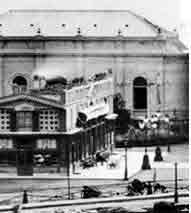 ame far more attractive to players. In fact, in turned roulette
into the most popular gambling game in Europe. ame far more attractive to players. In fact, in turned roulette
into the most popular gambling game in Europe.
Charles
Garnier, who built the Paris Opera House, was hired to build the new
casino. At first it was proposed to rename the "Plateau des Spélugues"
as Charlesville or even Albertville (after Charles' son and heir), but the
name settled upon in 1866 was Mount Charles or Monte Carlo.
Blanc arranged the building of the Hotel de Paris, completed on January
1st, 1864. Almost immediately the famous architect,
Godinot de la Bretonnerie, was commissioned to construct an addition. In
1868 the Café-Divan, whose building housed a café, a restaurant, a jewelry
shop and a tobacconist, was completed. All these structures were illuminated
by gaslight from Monaco's new gas facility. Most importantly, in 1868, the
laying of the Nice-Ventimiglia railway (it's existence greatly due to
Blanc's offering France 5 million francs in low-interest loans) and the
paving of some roads made Monte Carlo suddenly quite accessible. In
1869 an unprecedented 170,000 people visited Monte Carlo, a success
marked by the abolishment of taxation.
the original casino under construction
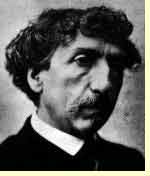
Charles Garnier
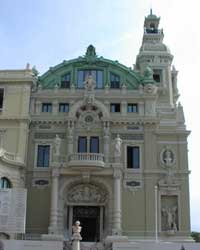 Théâtre de l’Opéra
Théâtre de l’Opéra
Prince Charles had gone blind by 1864 after
which Princess Caroline controlled things until her grandson, Albert, came
of age (Charles' wife - Albert's mother- Antoinette de Mèrode-Westerloo, had already died from cancer).
François Blanc died in 1877, leaving an estate of more than 200 million
francs. His widow, Marie ran the casino until her own death in 1881.
During her tenure, Charles Garnier was again commissioned, this time to
reconstruct the casino with the entertainment center, the Théâtre du Casino, its immense
gaming room and its trademark cupola crown with dual pinnacles. The Théâtre du Casino
(or the Théâtre de l’Opéra) was dedicated on
January, 25th 1879 with the world-famous Sarah Bernhardt reciting a poem.
Later the Opera, under the directorship of Raoul Gunsbourg, would feature
such illuminaries as Gigli, Caruso, Melba, Muzio, Patti, Tamagno,
Chaliapine, Garden, Schipa, Pons, Lubin, Thill and Dalla Rizza. An Atrium,
designed by Jean-Baptiste Dutrou, sported 28 columns and a huge, bronze
candelabra.
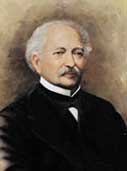
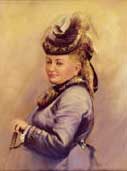
François Blanc
Marie Blanc
Prince Albert
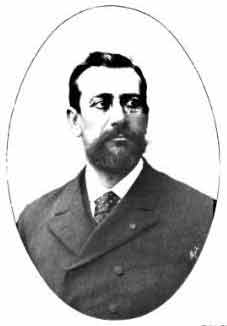
Marie and François' son,
Camille, ran Monte Carlo for the next sixty-five years. Camille Blanc, of
course, headed the Société des Bains de Mer or the Cercle des Etrangers,
as it was generally referred to at that time (now called SBM), at the time
of the 1902 tournament. Princess Caroline died in 1879. Prince Albert,
Charles' son, was more interested in scientific research, particularly
oceanography and paleontology, than in
the operation of government. Prince Albert married Marie-Victoire de
Douglas-Hamilton (their marriage was annulled in 1880) in 1869.
Their child, Prince Louis II, would succeeded his father in 1922 and carry
on the royal line. When Prince Charles died in 1889, Albert took over the
throne. Besides his research, he constructed the Oceanographic Institute,
the Museum of Prehistoric Anthropology in Monaco and the Institute of
Human Paleontology in Paris as well as the International Institute of
Peace.
Also in 1889, Albert married Marie Alice Heine, an American woman
originally from New Orleans. Her story parenthetically aligns with the
1902 tournament.
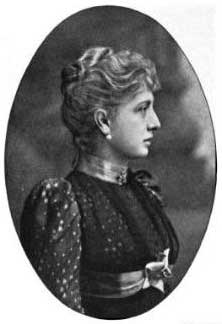
Princess Alice
Marie Alice was born in 1858 at 900-912 Royal St. in New Orleans, just a
few blocks from where the Morphy family lived. Her father was a
successful banker who made his original money in real estate. When the
American Civil War threatened to reach New Orleans, Michael Heine moved
his family to Paris. Incidentally, this was around the time Paul Morphy
also left for Paris. Marie Alice only returned to New Orleans twice in her
life. She became part of Paris society and married a Marquis. Her husband
died in 1880. Prince Albert had his first marriage annulled that
same year. Marie Alice later met Prince Charles and in 1889 when he
ascended the throne, they married. Since she brought to the union a
fortune equaling about 120 million dollars in today's currency, the
marriage was more a benefit for Albert and Monaco than for Marie Alice
Heine, now Princess Alice. Both Alice and Albert were idealists in their
own ways. They toyed with the idea of turning the Casino of Monte Carlo
into a hospital "for the poor and ailing who require a warm climate for
their delicate health." But practicality reigned. The Prince's ideals led
him to oceanography, while the Princess' ideals led her to the theatre,
the ballet, and the opera. But their ideals kept them apart and while the
Prince was riding "Princess Alice", his boat, the real Princess Alice
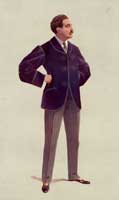 was
enamored with the operatic composer Isidore de Lara (real name: Isidore
Cohen). The affair lasted many years, but it all culminated during the
1902 Chess Tournament at Monte Carlo - on Feb.18th to be
exact. The Princess and Prince arrived at La Salle Garnier (in the
Théâtre de l’Opéra) to attend the opening of "Le Jongleur de Notre-Dame"
and the Princess stopped to whisper something in the ear of Isidore, whom
they had come across there and whom the Prince apparently recently started
suspecting to be her lover. When she turned to resume her entrance with
the Prince, he slapped her face in front of everyone. Alice continued to
the opera box as if nothing happened while Albert left. She never returned
to the palace and they officially separated on May 30. However, she never
divorced him and forever retained her title. Isidore remained her lover
(in Paris) and composed up until her death after which he never composed
again. was
enamored with the operatic composer Isidore de Lara (real name: Isidore
Cohen). The affair lasted many years, but it all culminated during the
1902 Chess Tournament at Monte Carlo - on Feb.18th to be
exact. The Princess and Prince arrived at La Salle Garnier (in the
Théâtre de l’Opéra) to attend the opening of "Le Jongleur de Notre-Dame"
and the Princess stopped to whisper something in the ear of Isidore, whom
they had come across there and whom the Prince apparently recently started
suspecting to be her lover. When she turned to resume her entrance with
the Prince, he slapped her face in front of everyone. Alice continued to
the opera box as if nothing happened while Albert left. She never returned
to the palace and they officially separated on May 30. However, she never
divorced him and forever retained her title. Isidore remained her lover
(in Paris) and composed up until her death after which he never composed
again.
Isidore de Lara
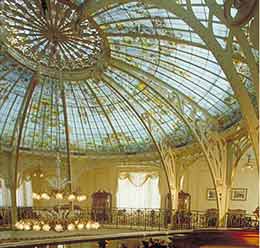 Under
the direction of Prince Albert, Princess Alice and Camille Blanc, Monte
Carlo continued to improve. The Hôtel Hermitage was revamped and its
Winter Garden was capped with a glass dome engineer by Gustave Eiffel
himself. The famous Rotonde wing was added to the Hôtel de Paris Under
the direction of Prince Albert, Princess Alice and Camille Blanc, Monte
Carlo continued to improve. The Hôtel Hermitage was revamped and its
Winter Garden was capped with a glass dome engineer by Gustave Eiffel
himself. The famous Rotonde wing was added to the Hôtel de Paris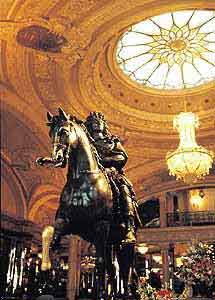 .
.
The the Café de Paris was rebuilt in 1897 along a Moorish style of
architecture. That very year, during a grueling auto race from Marseille
to Monte Carlo, Edouard Michelin, who developed detachable pneumatic tires
for cars and created a dynasty in the process, crashed his automobile into
one of the the pillars of the new Café de Paris.
Glass dome of
the Winder Garden
Rotonde wing of the Hôtel de Paris
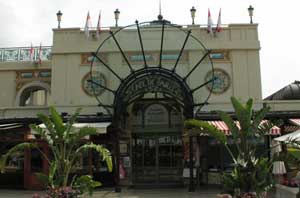 Café de Paris
Café de Paris
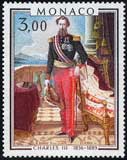
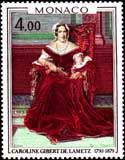
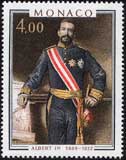
Prince Charles III
Princess Caroline
Prince Albert I
[1] The information on
the actual establishment of the Sea Bath Society is unclear and
contradictory. Presented here is one, reasonable, scenario.
[back]
Note 1: Monaco stems from the
Greek word Monoikos. This word was used exclusively in speaking
about Hercules, i.e. Herakles Monoikos, which means the Solitary
Hercules. Monaco was the Port of Monoikos.
Note 2: In 1902, the year of the
tournament, a movie was filmed in Monte Carlo entitled Ten Minutes at
Monte Carlo. Basically, a camera was mounted in a motorcar which drove
from the Credit Lyonnais in Monte Carlo to the Place du Palais de
Monaco. According to this
review site, "It shows at first to the spectator a perspective of
gardens, having for a background the magnificent Casino, at the angle of
which the sea suddenly breaks into view. Immediately a hilly landscape is
entered into, the descents and ascents being perfectly felt. On the right
can be seen the elegant vision of hotels, villas, and balustrades emerging
from the grass; on the left, at intervals, the sea, and in the distance
the rock of Monte Carlo dominated by towers from which floats the flag of
Monaco. Through this landscape, essentially changing and lively, the
Railway Station of Monaco is reached, from which, after attacking a stiff
incline and going beneath a row of overhanging trees, we arrive at the
Place du Palais, where the troops of the principality are defiling."
|
